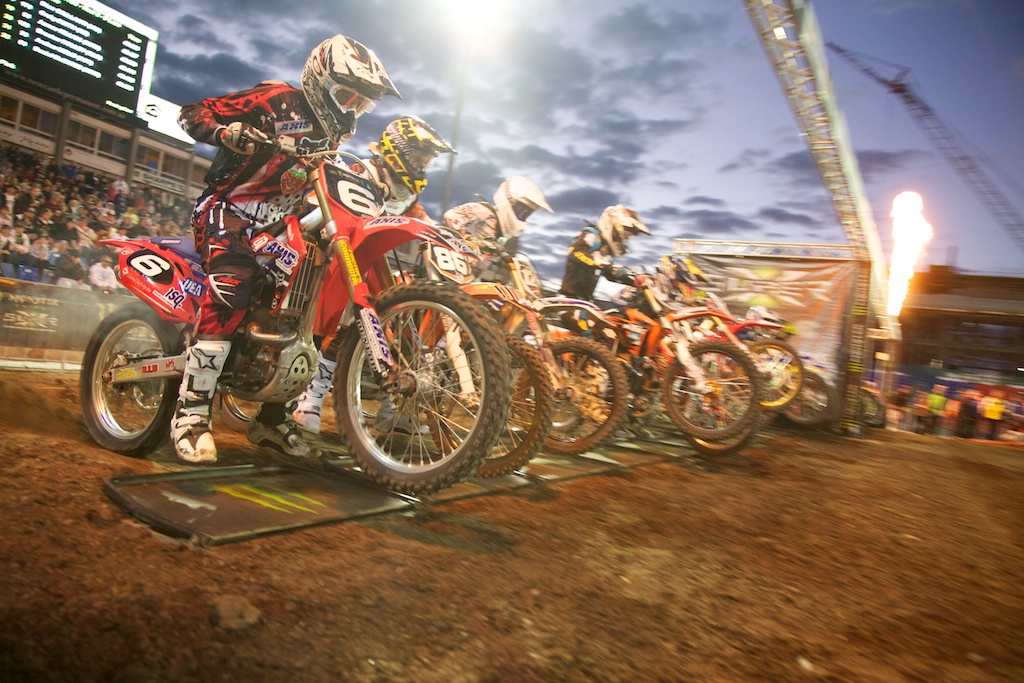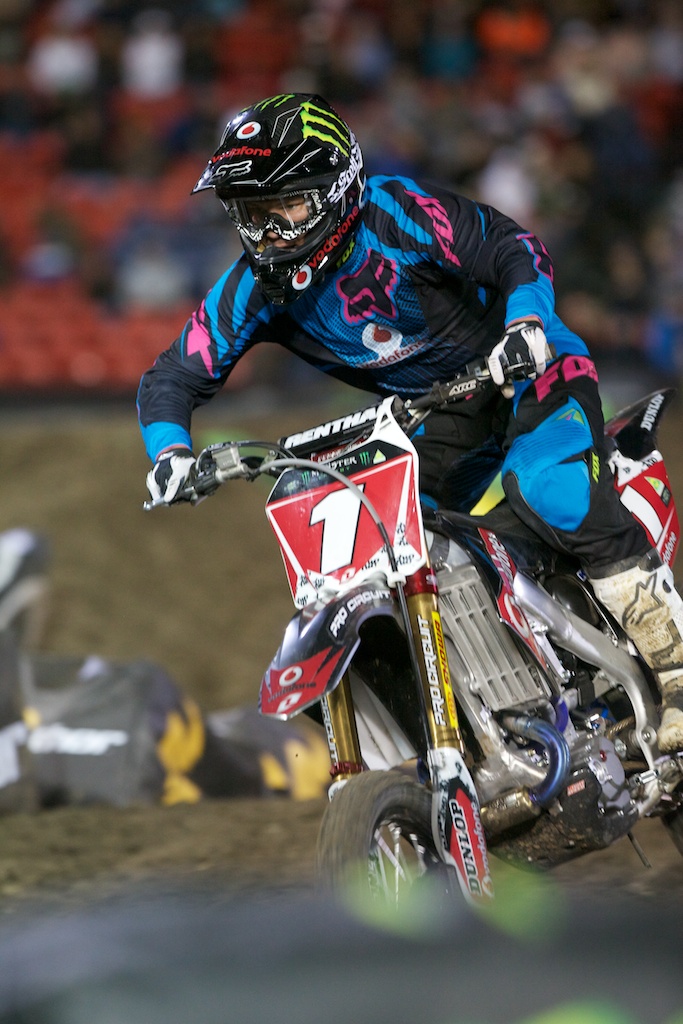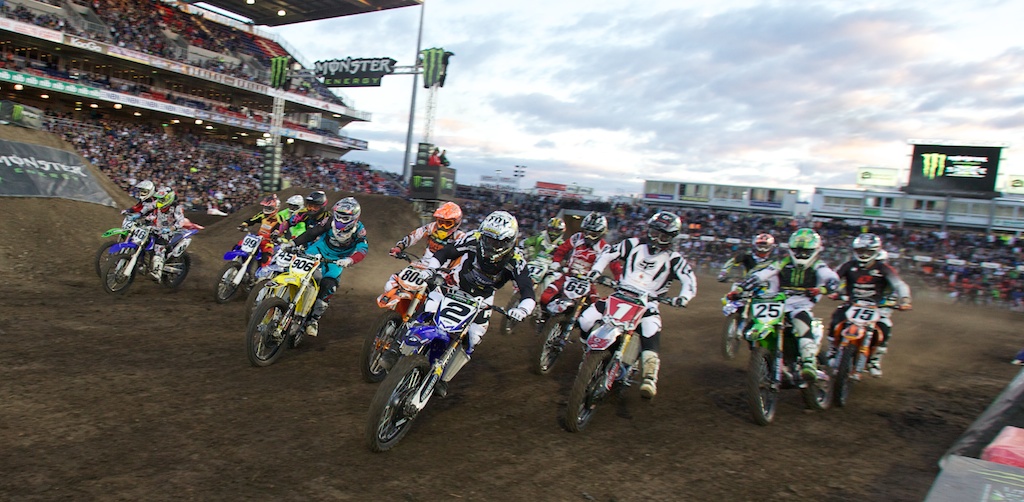Last Updated on 01/26/2011 by Chris Gampat

Covering a Supercross event is tough: sports arena lighting seems bright to the spectators, but isn’t actually very bright. Also the lighting is very flat – if you get shadows at all you usually get at least six – and the action is fast a furious, so fast shutter speeds are often required.
With tough shooting conditions and a professional assignment – I needed some news images for my magazine’s website and next edition, and coverage of a particular team for a feature article – I brought out the big guns – Canon EOS 1D MkIIN, 5D MkII, 17-35mm f/2.8L, 24-105mm f/4L, 70-200mm f/2.8L IS and 300mm f/2.8L IS, two flash guns and various accessories.
Away From the Action
I spent the afternoon in the pits with the feature article race team, getting shots of mechanics working on the bikes, riders signing autographs: the background images which often really give the reader an insight into the background behind the action.
For these images I used wide angle lenses and got in close, often with wide apertures to keep depth of field tight.
Trackside
In Supercross there are heat races in the early evening, with about half of each race going through to the final, or main event, of reach racing class. This means if a rider has a mishap in his heat, there’s a good chance he will be out of the competition: so it was crucial I got some good shots of the important people in each race they contested, so I made sure I knew which rider numbers I just had to shoot.
Luckily for me – but not for the rider – one of my race team riders drew the outside gate, which means he was starting his heat from as far to the right of the starting line as possible, which meant I could crouch down very close to the gate and shoot the start with the right bike filling the frame.
It turned out to be the shot of the night, because just seconds after the start both team riders were caught up in a first-turn crash, and by the time they had picked up their bikes and got going again they were last and second-last.
At least they were going so I managed to get shots of them in action but they couldn’t make up so much lost time and failed to qualify for the main event, which was a big shame for them, but at least I had some images to illustrate the story.
Photo Techniques
Throughout the night I used a variety of techniques to capture different styles of image.
I balanced the fading natural light with flash to get an evening feel. I shot without flash – ISO up to 3200 – so I could use high shutter speeds and stop action. I used long shutter speeds to get deliberate blur in the moving bikes. I shot wide to include the stadium, I shot telephoto to isolate a rider from the background.

Because you’re really close to the action and the riders are continually going up and down through the jumps, whoops and bends at a Supercross, using tripods or even monopods is difficult at best, so I don’t bother – but the next morning my wrist ached from hand holding that Canon EF 300mm f/2.8L IS USMand 1D MkIIN combination.
Flash is a big problem at a Supercross. The fastest flash sync speed of the 1D is 1/250s, but many shots showed ‘ghosting’ as the stadium lights are enough to provide a little bit of exposure at that shutter speed, so as the bike moves it results in a double image – one from the flash, one from the stadium lights. Dialing the ISO down solves this, but your background goes pitch black. Using high-speed flash sync is great if you’re close enough, for your flash’s range is very limited in these conditions.

I like to work with the ambient light, using flash for fill, and if there’s blur in the shots, well, it’s an action sport…
I feel the same way about noise. Sure, I’d love a 1D MkIV or Nikon D3S for their better high ISO performance, but it’s an expensive upgrade, and I do use my 5D Mk II, which is great even at 3200ISO.

If you get the chance to shoot a Supercross, take it: it’s a lot of fun. If you don’t have high-speed zooms, use a fast 50mm or rent a 24-70 f/2.8. A big flash is very useful and don’t be afraid to push the ISOs up high.
Post Production
In Aperture it’s handy to import using stacks, because the feature hides groups of shots behind the first frame of a sequence, making it easier to sort the dross from the keepers. Tweak the images by making sure your black point is really black, there’s enough contrast in the images, the white balance is good and the sharpness makes the subject stand out. Be careful noise isn’t intrusive.
Please Support The Phoblographer
We love to bring you guys the latest and greatest news and gear related stuff. However, we can’t keep doing that unless we have your continued support. If you would like to purchase any of the items mentioned, please do so by clicking our links first and then purchasing the items as we then get a small portion of the sale to help run the website.

